Dare to be Free: The Scottish Suffragettes
As in other parts of the British Isles, groups demanding votes for women had been active for decades before the franchise was finally extended in 1918, a centenary just celebrated by marches through London, Cardiff, Belfast and Glasgow. In Scotland there had been women’s suffrage committees for thirty years and more, from Lerwick to Dumfries and all points in between. Many of Scotland’s town councils had declared their support. From 1882, Scotswomen who were householders in their own right could vote in local elections. After that, it seemed increasingly absurd to many that women could not vote in general elections.
The term suffragette was initially a derogatory one coined by the Daily Mail for the more militant campaigners, the foremost of whom was Mrs Pankhurst. In Scotland and elsewhere, suffragists collected signatures on petitions, wrote articles, spoke at public meetings and organized peaceful protests. In 1909 the Gude Cause march along Princes Street excited lots of interest. Hundreds of women were supported by a contingent from the Men’s League for Women’s Suffrage. One of their banners read: Scots wha hae votes – men. Scots wha haena – women. Although around 25% of Scotsmen still didn’t have the vote either, essentially younger men who were not householders.
There was lots of soap-box oratory. Helen Fraser regularly addressed Glasgow Fair holiday-makers at Rothesay, where the Women’s Freedom League – slogan, Dare to be Free – had a summer base. She impressed her namesake and fellow Glaswegian Helen Crawfurd, indignant though the latter was about heckling from the crowd. “It’s a man ye want,” sneered one ‘underweight bantam’.
Helen Crawfurd later went on a speaking tour of Lanarkshire with sisters Frances and Margaret McPhun. They were touched and heartened by the warm welcome they received from the miners. Not only did they waive the usual fee for the hire of their halls, they took up a collection at each meeting, donating the shillings and sixpences to the cause of votes for women. Class clearly wasn’t an issue for those Lanarkshire miners. Unfairness was unfairness.
However, then and now, the fact that many suffragettes were well-off ladies has provoked mockery. Ramsay MacDonald spoke of “pettifogging middle-class damsels going out with little hammers in their muffs.” It seems a grudging reaction to women who might have lived comfortable lives but chose instead to give freely of their time, money and resources. Many put their liberty and health on the line. In 1912 several Scottish suffragettes travelled to London for the express purpose of breaking windows in an organized three-day attack. Among those arrested as a result were Helen Crawfurd, the McPhun sisters and Janie Allan. Her father was Alexander Allan, owner of the shipping company of the same name. She went on hunger strike and was force-fed for a week. Ten thousand Glaswegians signed a petition objecting to her imprisonment and harsh treatment.
While researching my book on the social history of Red Clydeside, When the Clyde Ran Red, it came as a surprise to me to find that so many Scottish suffragettes had fully earned their place within radical and left-wing politics. Janie Allan was a committed socialist and member of the Independent Labour Party. So was Helen Crawfurd, who later moved farther to the left, becoming one of the Scottish founder members of the Communist Party of Great Britain. Mrs Pankhurst and her daughters were members of the ILP and personal friends of Keir Hardie, stalwart supporter of votes for women. Sylvia Pankhurst was a friend of socialist martyr John Maclean, visiting him at his home in Pollokshaws a year or so before he died.
Tom Johnston, later secretary of state for Scotland, was a young political firebrand and editor of Socialist newspaper Forward! He started a regular column, Suffrage Notes. Janie Allan, the McPhun sisters and Helen Crawfurd were regular contributors.
Helen Fraser, who had been heckled at Rothesay, told Mrs Pankhurst: “You don’t use violence, you use reason to get the vote.” Others disagreed. In the two years before the outbreak of war, suffragettes burned down the railway station at Leuchars in Fife, planted a bomb in Glasgow’s Botanic Gardens and tried to blow up Burns’ Cottage in Alloway. So the sound of breaking glass was heard in Scotland too. Glasgow glazier James Caldwell took out an advert in Forward! “Suffragettes may break windows, but I am the wee boy [that] can put them in.”
In October 1913, Dorothea Chalmers Smith and Ethel Moorhead were tried at Glasgow High Court for attempted arson at a large empty house in the city’s West End. Chalmers Smith was a doctor, mother of six and wife of the minister of Calton Parish Church. Her social status did not save her. She and Ethel Moorhead were found guilty and sentenced to eight months in prison.
Pandemonium ensued. Their friends in the public gallery stood up and began pelting the judge and officers of the court with apples. Eye-witness Helen Crawfurd noted that they were small ones, bagged ready for Halloween guisers. The apple throwers chanted “Pitt Street! Pitt Street!” Shortly before, a husband and wife who kept a brothel there had been given a sentence of only two weeks. The message was clear. Property mattered more than the sexual exploitation of women and girls.
The suffragettes’ agenda was never a narrow one. Dorothea Chalmers Smith went on to set up child welfare clinics. She also supported Glasgow’s first birth control clinic, as did Janie Allan.
Ethel Moorhead became the first woman in Scotland to be force-fed. Helen Crawfurd was addressing a protest vigil outside Perth Prison when news came through of the attempt to blow up Burns’ Cottage. Sensing the crowd’s sympathies might be about to swing away from the suffragettes, she turned the situation around by quoting Burns. In the revolutionary fervour following the publication of The Rights of Man, the rights of woman also merited some attention.
Media savvy, the suffragettes knew what made for a good photo opportunity and how to harness their Scottishness. Mary Phillips of Glasgow came out of Holloway to a welcoming committee. Draped in tartan sashes pinned with Cairngorm plaid brooches, the women carried a banner emblazoned with a thistle and a warning to Prime Minister Asquith: “Ye mauna tramp on the Scotch thistle, laddie!”
When it was suggested to Mary Phillips that women were more likely to get the vote if they behaved with ladylike decorum, she replied that she’d rather be a “great big, prickly, Scots thistle.”
Active in the Scottish branch of the non-militant National Union of Women’s Suffrage Societies, Dr Elsie Inglis was a bit of a prickly thistle herself. When war broke out in August 1914, she offered to set up field hospitals staffed by female doctors, nurses and orderlies who were members of the NUWSS.
“My good lady,” said the man at the War Office, “go home and sit still.” Elsie Inglis gave that remark the contempt it deserved. The Scottish Women’s Hospitals treated the wounded throughout the war in France, Russia and Serbia.
Although many suffragettes were confirmed pacifists, a truce was declared with the government for the duration of the war. In 1918, women over 30 and all men over 21 were given the vote. In 1928, the suffrage was extended to all women over 21. The struggle for gender equality continues.
This article first appeared in the online Scottish Review.

